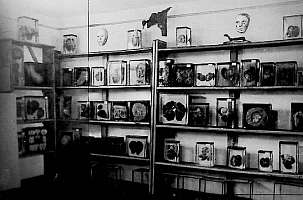Medical Experiments
The KZ Gusen “Medical” Unit

Barracks No. 27 to 32 were used for KZ Gusen´s ill and unfit inmates. All these barracks were located directly near the crematorium of KZ Gusen, where Dr. Kaminski was chief of autopsy and chief prosector.
From 1940 to February 1944, Jews were forbidden medical help. Nor was medical treatment availble for Soviet prisoners between 1941 and 1942. Neither Jewish nor Soviet inmates could receive any narcotics when undergoing medical experiments.
Little medicine and no bandaging material were available, so prisoners were left to use paper or whatever else they could find.
All inmates with typhoid fever or tuberculosis were, in general, isolated in a special part of barrack No. 30 called “Graben” (ditch) and given fatal heart injections. In some cases, prior to killing these inmates, medical experiments were carried out on them.
In 1945, all inmates of Camp Mauthausen suffering from tuberculosis were sent to Block No. 30 of Gusen´s “medical” unit to die.
The baracks were used as follows:
- Block 26: Logistics
- Block 27: Pathological Unit, Dr. Helmut Vetter
- Block 28: Chirurgical Unit, Dr. Toni Goscinski
- Block 29: Infected inmates
- Block 30: Infected inmates stayed here, the sight of the “Graben” (ditch), where fatal heart injections were given.
- Block 31: Infected inmates, particularly those with diarrhea, stayed and died here, at sight of the “Bahnhof” (railway-station), meaning the death chamber
- Block 32: Convalescent inmates stayed here.
Inmates with diarrhea wer sent to “Bahnhof” at Block No. 31 and refused any medical attention. Neither the doctors, nor other prisoners entered this barrack. Even the little food available was not brought in, but left at the front entrance. From time to time the “Blockaelteste” (block elder) entered to beat the starving inmates to death with a wooden stick. Between 1940 and 1942, KZ Gusen inmates´ average weight was 42 kilograms. Some only weighed 28 to 36 kilograms. Between 1940 and 1942, inmates survived on average only 6 months. In 1943 and 1944, this survival period increased to 9 and even 12 months, due to the armament projects, but dropped rapidly again in 1945 with the increased deportations from other camps.
The KZ Gusen Pathological Museum
Located in Block 27, this museum displayed 286 specimen of human organs harvested at KZ Gusen in connection with the SS Medical Academy at the University of Graz.
The photograph shows hearts, lungs, kidneys, faces, skeletons and skulls of murdered KZ Gusen inmates. In some cases, inmates were killed by heart injections to preserve their anatomical “anomalies” .
The museum also contained an album of tattooed skin.
Other “artwork” , such as lamp shades and even furniture, was produced here. In 1944, three big crates of anatomical preparations were transferred to SS Medical Academy at Graz.
This photograph shows one of this face preparations in the upper-left corner, to the left of the full size skeleton).
SS-Doctors at KZ Gusen
-
SS-Hauptsturmfuehrer Dr. Helmut Vetter: As an employee of IG-Farben and Leverkusen, he carried out medical experiments with different medicines at KZ Gusen. Specializing in tuberculosis, he experimented in 1944 with “Ruthenol” and “Praeparat 3582? at Block No. 27. He also carried out similar experiments at KZ Auschwitz.
- Dr. Herbert F. Heim: Besides his private experiments, he specialized in the preparation of human heads. Some of these preparations were exhibited in the KZ Gusen Pathological Museum. Still others were sent to Dr. Heim´s friends as special gifts or were used as weights on his writing desks.
- Dr. Eduard Krebsbach: Between October 1941 and Autumn 1943, he was Chief Physician of the SS and the Police at Linz, Steyr, Wels and KZ Mauthausen-Gusen. First to execute ill and unfit prisoners en mass with heart injections, inmates nicknamed him “Dr. Spritzbach”, or “Dr. Injection”. Especially at KZ Gusen, these heart injections became nearly daily events. In January 1942 732 Spaniards and 571 Soviets were exterminated by injection. In general, heart injections were given at KZ Gusen twice a week until 1945. Dr. Krebsbach´s career at KZ Mauthausen-Gusen ended when he shot Josef Breitenfellner, a soldier from the nearby town of Langenstein who served in the German Army. Krebsbach shot this vacationing young man at his private home, because he and his friends disturbed Krebsbach in the night of May 22, 1943. As a result of this indiscretion, Dr. Krebsbach was transferred from KZ Mauthausen-Gusen to KZ Warwara, where he conducted selections along with the liquidation of that camp in August 1944. After this, he resumed his career as Inspector for Epidemics in occupied Lettland, Estland, and Lithuania.The following SS doctors refused to give heart injections at KZ Gusen: Dr. J. Fried, Dr. B. Adolph, and Dr. K. Boehmichen
- Dr. Hermann Kiesewetter: He performed meaningless surgeries on KZ Gusen inmates. To study the function of the human brain, he also carried out trepanations on them.
- Dr. Hermann Richter: Similar to Dr. Kiesewetter, Richter carried out surgery on KZ Gusen inmates without reason.
#RememberGusen